Stress
Hormones Help Predict Who’s Likely to Suffer During Stress
Insights from a study on stress hormones in pregnant and non-pregnant women.
Posted September 21, 2023 Reviewed by Gary Drevitch
Key points
- A new study suggests hormonal activity predicts who is likely to develop depressive symptoms during stress.
- The link between hormones and depressive symptoms was found in both pregnant and non-pregnant women.
- Risk markers like this are important for targeting interventions to improve mental health.

When going through stressful experiences, some people are able to maintain good mental and emotional well-being, while others have a much harder time, and can develop depressive symptoms. These symptoms include feelings of hopelessness and sadness, loss of interest in typical activities, changes in sleep and appetite, difficulty concentrating, and even thoughts of suicide. But how can we know in advance who’s more likely to develop depressive symptoms during stress? The stress hormone, cortisol, might be a useful clue.
The stress hormone and depression: What we know
Past studies have found that the concentration of the stress hormone, cortisol, goes up during psychosocial stress tests. The most well-known of these tests is called the Trier Social Stress Test. This test is designed to include situations that make people uncomfortable, such as doing math out loud in front of others, as well as preparing and presenting a short speech to a panel of judges. The amount of additional cortisol released during this test can be measured through saliva samples. This increase in cortisol is also called cortisol reactivity. Research has found a possible link between higher cortisol reactivity and higher depressive symptoms.
The stress hormone and depression: What we don’t know
Unfortunately, most studies on cortisol and depression only measure cortisol reactivity and depressive symptoms at a single point in time. With this type of study, we can’t know which happens first, higher cortisol reactivity or higher depressive symptoms. If higher cortisol reactivity comes first, this could be a useful way to predict who will experience increases in depressive symptoms later on. However, studies using multiple time points are limited. This gap in the research is especially noticeable for certain groups, such as pregnant individuals, who are often not included.
Why should we study the stress hormone in pregnancy?
Pregnancy involves a lot of social and biological changes. While pregnancy and having a new baby can be exciting, it can also be very stressful. Studies suggest that about 7 percent of people experience depression during pregnancy and 15 percent during the postpartum period, after birth. Because depression during the postpartum period is so common and can also impact the child, it is important to know who is more likely to develop depressive symptoms during this time. However, few studies have examined cortisol reactivity during pregnancy, and even fewer have included follow-ups going into the stressful postpartum period.

How can we study real-life stress?
Usually, when researchers want to study stress, they have people come into the lab and participate in short, stressful tasks. However, it’s unclear how much people’s reactions in these artificial situations relate to their reactions during real-life stress, such as the postpartum period or other more general stressful experiences. Real-life stress can be difficult to study since the timing of stressful events is often unpredictable, and very different for different people.
In April 2020, the stressful circumstances surrounding the initial stage of the COVID-19 pandemic enabled researchers to study reactions to widespread, real-life stress. In this stage of the pandemic, vaccines were not yet available, stay-at-home orders were common, social gatherings were prohibited, and most daycares, schools, and workplaces were closed. We know from multiple studies that this time period was associated with significant declines in mental health, with women, people living alone, and unpaid caregivers showing greater levels of depression. Across the world, the prevalence of depression and anxiety increased between 25 percent and 30 percent (Santomauro et al., 2021). Many researchers have started to examine whether there might be biological markers (measured prior to the pandemic) that predict increases in depressive symptoms during widespread real-life stress (during the pandemic). Biological markers, such as hormonal or brain activity, can provide objective measures of risk, which is important because people aren’t always open about how they’re feeling with loved ones or health care providers.
The current study
A group of researchers from Yale University, led by Abigail Beech and Dr. Reuma Gadassi-Polack (Beech et al., 2023), performed a study to examine whether cortisol reactivity to a psychosocial stress test predicts depressive symptoms in women during real-life stress; specifically, the COVID-19 pandemic. (I was a co-author of the study.) Prior to the pandemic (January 2018 – 2020), the researchers recruited two groups of participants: pregnant women and non-pregnant women who had never had children. These participants completed a stress test in the lab, during which they were asked to prepare a speech for a panel of judges and complete mental math in front of the researchers, and provided saliva samples to later quantify cortisol reactivity. Participants also completed a depressive symptoms questionnaire. Then, during the initial stage of the pandemic (April 2020; at which point the pregnant participants had already had their babies), participants were contacted again to report their current depressive symptoms. Sixty-eight participants completed both timepoints, with similar numbers from each group.
Main findings: A link between increased stress hormone activity and increased depressive symptoms
The researchers first compared the two groups to see if there were any differences in depressive symptoms. Before the pandemic, the pregnant participants had significantly higher depressive symptoms than the non-pregnant participants, which fits with the research mentioned above, showing that pregnancy is a time when many women experience higher depressive symptoms. Surprisingly, there were no significant group differences in depressive symptoms during the pandemic. This is surprising because, although both groups were dealing with the stress of the pandemic, the previously pregnant group had the added stress of caring for their young children. Given that non-pregnant participants were more likely to be single and reported a smaller household size, it may be that living alone or without a partner during the early pandemic also enhanced pandemic-related stress in the non-pregnant group.
After this, researchers analyzed the association between cortisol reactivity and change in depressive symptoms over time. They found that higher cortisol reactivity before the pandemic predicted increases in depressive symptoms during the pandemic for both pregnant and non-pregnant participants. This means that people with high cortisol reactivity were at greater risk for mental health difficulties during real-life stress.
Takeaways
So, what does this all mean? Overall, these findings suggest that there are biological differences related to who is more likely to react badly to stress. Specifically, in this study, people with higher cortisol reactivity had higher increases in depressive symptoms during the stressful experiences of the pandemic and the postpartum period. In the future, this kind of information might be able to be used to develop objective tests to find people more prone to suffer during stress and help them in advance, by providing mental health resources or other strategies to cope with stress.
References
Beech, A., Edelman, A., Yatziv, T., Rutherford, H. J., Joormann, J., & Gadassi-Polack, R. (2023). Cortisol reactivity to a laboratory stressor predicts increases in depressive symptoms in perinatal and nulliparous women during population-level stress. Journal of Affective Disorders, 340, 33-41. https://doi.org/10.1016/j.jad.2023.07.093




